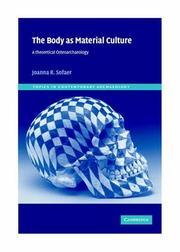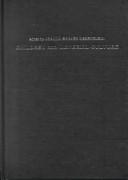| Listing 1 - 9 of 9 |
Sort by
|

ISBN: 0521818222 9780521521468 0521521467 9780521818223 9780511816666 1316042588 0511816669 Year: 2006 Volume: 4 Publisher: Cambridge Cambridge University Press
Abstract | Keywords | Export | Availability | Bookmark
 Loading...
Loading...Choose an application
- Reference Manager
- EndNote
- RefWorks (Direct export to RefWorks)
Bodies intrigue us. They promise windows into the past that other archaeological finds cannot by bringing us literally face to face with history. Yet 'the body' is also highly contested. Archaeological bodies are studied through two contrasting perspectives that sit on different sides of a disciplinary divide. On one hand lie science-based osteoarchaeological approaches. On the other lie understandings derived from recent developments in social theory that increasingly view the body as a social construction. Through a close examination of disciplinary practice, Joanna Sofaer highlights the tensions and possibilities offered by one particular kind of archaeological body, the human skeleton, with particular regard to the study of gender and age. Using a range of examples, she argues for reassessment of the role of the skeletal body in archaeological practice, and develops a theoretical framework for bioarchaeology based on the materiality and historicity of human remains.
Human remains (Archaeology) --- Menselijke overblijfselen (Archeologie) --- Menselijke resten (Archeologie) --- Overblijfselen [Menselijke ] (Archeologie) --- Resten [Menselijke ] (Archeologie) --- Restes humains (Archéologie) --- Skeletal remains (Archaeology) --- Restes humains (Archéologie) --- Social Sciences --- Archeology --- Bioarchaeology --- Human skeleton --- Primate remains (Archaeology)

ISBN: 1134659016 1134659024 1280108673 0203991869 9780203991862 9786610108671 6610108676 9780415188975 0415188970 9780415188982 0415188989 0415188970 0415188989 9781134658978 9781134659012 9781134659029 Year: 2000 Publisher: London Routledge
Abstract | Keywords | Export | Availability | Bookmark
 Loading...
Loading...Choose an application
- Reference Manager
- EndNote
- RefWorks (Direct export to RefWorks)
This is the first book to focus entirely on children and material culture. The contributors ask:* what is the relationship between children and the material world?* how does the material culture of children vary across time and space?* how can we access the actions and identities of children in the material record?The collection spans the Palaeolithic to the late twentieth century, and uses data from across Europe, Scandinavia, the Americas and Asia. The international contributors are from a wide range of disciplines including archaeology, cultural and biological anthropology,
Children, Prehistoric. --- Children --- Material culture. --- Industries, Prehistoric. --- Archaeology and history. --- Civilization, Ancient. --- Civilization, Medieval. --- Civilization, Medieval --- Medieval civilization --- Middle Ages --- Civilization --- Chivalry --- Renaissance --- Ancient civilization --- Historical archaeology --- History and archaeology --- History --- Prehistoric industries --- Culture --- Folklore --- Technology --- Prehistoric children --- Prehistoric peoples --- History. --- Age group sociology --- History of civilization --- Industries, Primitive
Book
ISBN: 1784917559 9781784917555 9781784917548 1784917540 Year: 2018 Publisher: Summertown, Oxford
Abstract | Keywords | Export | Availability | Bookmark
 Loading...
Loading...Choose an application
- Reference Manager
- EndNote
- RefWorks (Direct export to RefWorks)
Creativity is embedded in human history. Indeed, it is impossible to understand material change and the development of the new without invoking creativity. The location, exploration and analysis of creativity should therefore be of particular concern to archaeologists. This volume engages with this challenge by focusing on the outcomes of creativity - material culture - and an exploration of creative practice. The European Bronze Age provides a useful focus for discussions of the outcomes of creativity because in this period we see the development of new and pre-existing materials that we take for granted today, in particular textiles and bronze. We also see new ways of working with existing materials, such as clay, to create novel forms. In both new and existing materials it is frequently possible to see the growth of technical skill, to produce complex forms and elaborate decorated surfaces.
Bronze age --- Creative ability --- Creativeness --- Creativity --- Ability --- Creation (Literary, artistic, etc.) --- History --- Europe --- Council of Europe countries --- Eastern Hemisphere --- Eurasia --- Antiquities. --- Civilization
Multi
ISBN: 9781139045636 9780521768269 9780521155366 Year: 2015 Publisher: Cambridge Cambridge University Press
Abstract | Keywords | Export | Availability | Bookmark
 Loading...
Loading...Choose an application
- Reference Manager
- EndNote
- RefWorks (Direct export to RefWorks)
Bronze age --- Europe
Digital
ISBN: 9780511816666 Year: 2006 Publisher: Cambridge Cambridge University Press
Abstract | Keywords | Export | Availability | Bookmark
 Loading...
Loading...Choose an application
- Reference Manager
- EndNote
- RefWorks (Direct export to RefWorks)
Book
ISBN: 9781108421362 1108421369 1108432069 1108381758 110838367X 1108344356 9781108344357 9781108383677 9781108432061 Year: 2018 Publisher: Cambridge
Abstract | Keywords | Export | Availability | Bookmark
 Loading...
Loading...Choose an application
- Reference Manager
- EndNote
- RefWorks (Direct export to RefWorks)
Creativity is an integral part of human history, yet most studies focus on the modern era, leaving unresolved questions about the formative role that creativity has played in the past. This book explores the fundamental nature of creativity in the European Bronze Age. Considering developments in crafts that we take for granted today, such as pottery, textiles, and metalwork, the volume compares and contrasts various aspects of their development, from the construction of the materials themselves, through the production processes, to the design and effects deployed in finished objects. It explores how creativity is closely related to changes in material culture, how it directs responses to the new and unfamiliar, and how it has resulted in changes to familiar things and practices. Written by an international team of scholars, the case studies in this volume consider wider issues and provide detailed insights into creative solutions found in specific objects.
Antiquities. --- Bronze age --- Bronze age. --- Creative ability --- Creative ability. --- Material culture --- Material culture. --- Metal-work, Prehistoric --- Metal-work, Prehistoric. --- Pottery, Prehistoric --- Pottery, Prehistoric. --- Textile fabrics, Prehistoric --- Textile fabrics, Prehistoric. --- History --- Europe --- Europe. --- Technology --- Industrial arts --- Industries, Prehistoric. --- Industries, Primitive --- Prehistoric industries --- Arts, Useful --- Mechanic arts --- Trades --- Useful arts --- Handicraft --- Applied science --- Science, Applied --- Science --- Industries, Prehistoric
Digital
ISBN: 9781108344357 Year: 2018 Publisher: Cambridge Cambridge University Press
Abstract | Keywords | Export | Availability | Bookmark
 Loading...
Loading...Choose an application
- Reference Manager
- EndNote
- RefWorks (Direct export to RefWorks)
Book
ISBN: 1784915319 9781784915315 Year: 2016 Publisher: Oxford
Abstract | Keywords | Export | Availability | Bookmark
 Loading...
Loading...Choose an application
- Reference Manager
- EndNote
- RefWorks (Direct export to RefWorks)
Croatia --- Antiquities
Book
ISBN: 9781784915308 1784915300 Year: 2016 Publisher: Oxford : Archaeopress Publishing,
Abstract | Keywords | Export | Availability | Bookmark
 Loading...
Loading...Choose an application
- Reference Manager
- EndNote
- RefWorks (Direct export to RefWorks)
Excavations (Archaeology) --- Human settlements --- Material culture --- Croatia --- Antiquities --- History
| Listing 1 - 9 of 9 |
Sort by
|

 Search
Search Feedback
Feedback About UniCat
About UniCat  Help
Help News
News